介词与连词讲解与练习(答案)
- 格式:docx
- 大小:20.87 KB
- 文档页数:6
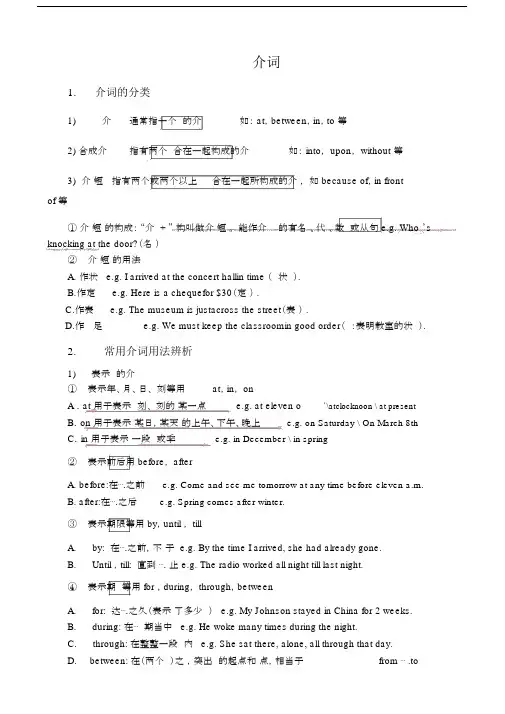
介词1.介词的分类1)介通常指一个的介如:at,between,in,to等2) 合成介指有两个合在一起构成的介如:into,upon,without等3)介短指有两个或两个以上合在一起所构成的介,如 because of,in frontof 等①介短的构成:“介 + ” 构叫做介短。
能作介的有名、代、数或从句 e.g. Who ’s knocking at the door?(名)②介短的用法A. 作状 e.g. I arrived at the concert hallin time (状).B.作定 e.g. Here is a chequefor $30(定) .C.作表 e.g. The museum is justacross the street(表) .D.作足 e.g. We must keep the classroomin good order(:表明教室的状).2.常用介词用法辨析1)表示的介①表示年、月、日、刻等用at,in, onA .at 用于表示刻、刻的某一点 e.g. at eleven o’\atclocknoon \ at presentB.on 用于表示某日,某天的上午、下午、晚上 e.g. on Saturday \ On March 8th C.in 用于表示一段或季 e.g. in December \ in spring②表示前后用 before, afterA. before:在⋯.之前 e.g. Come and see me tomorrow at any time before eleven a.m.B. after:在⋯.之后 e.g. Spring comes after winter.③表示期限等用 by,until , tillA.by: 在⋯.之前,不于 e.g. By the time I arrived, she had already gone.B.Until ,till: 直到⋯. 止 e.g. The radio worked all night till last night.④表示期等用 for ,during, through,betweenA.for: 达⋯.之久(表示了多少) e.g. My Johnson stayed in China for 2 weeks.B.during: 在⋯期当中 e.g. He woke many times during the night.C.through: 在整整一段内 e.g. She sat there, alone, all through that day.D. between: 在(两个)之,突出的起点和点,相当于from ⋯ .toe.g. He kept on working between seven and twelve last night.⑤表示的起点用 from, sinceA.from: 从⋯.起 e.g. From sunrise to sunset he waited.B.since: 自从⋯.以来 e.g. Since my last letter I have heard from him twice.⑥表示的等用 in,withinA.in: ⋯.后(未来) e.g. I heard that she would be back in a month.B.within: 以内,不超 e.g. He will arrive within an hour.2)表示所、方向的介①表示所的介:at,in,on,above,over,under,below,near,by,between,among,around, round,about,in front of , behinde.g. There are many trees around the lake.【注】表示“某地在⋯.里” 要用 in(包含关系);表示“某地在另外一地某方向” 要用 on 或 to;如果两地有空距离(不接壤),必用 to②表示方向的介: in,into,out of,along,down,across,through,to,towards,for ,from,over,by, paste.g. You must put the dirty paper in the basket.3)表示原因的介①常用来表示原因的介有 because of,for e.g. Because of her illness my grandma stayedin bed for a week.②某些其他介也可用来表示原因,如 at,from ,with ,of e.g. The old man died of cancer.4)其他介的用法①表示手段和材料等用法的介 :with ,in,byA .with :和⋯在一起,有、具有,用某种工具或方法 e.g. He is playing with his children. B.in:以⋯形式,以⋯方式;用⋯言;表示衣着、声特点 e.g. She keeps a diary inEnglish.C.by:被⋯ e.g. Around the city were mountains covered by snow.②表示“由⋯.制成”的介 :of ,fromA.of :表示成品看得出原材料 e.g. The table is made of wood.B.from :表示成品看不出原材料 e.g. This kind of paper is made from wood.③表示其他的介 :without , like ,as,against等A.without :没有 e.g. He rushed to the office without having his breakfast.B.like :像,如,跟⋯一 e.g. What ’ s he like?C.as:作 e.g. He is famous as a scientist here.D.against:靠着,反对 e.g. Don ’ t stand against the door.3.常见的介词短语1)动词 +介词look after, prepare for, agree with, listen to,wait for2)Be+形容词 +介词 be proud of,be different from,be famous for, be pleased with,be kind to, be good at,be late for,be afraid of3)名词 +介词key to,reason for, difficulty in ,progress in,way of4)固定介词搭配at the moment,by chance, by turns,for ever, in fact,on business中考题库 4介词选择题1.(2010.河北中考 ) Sally is very happy. There is a big smile her face.A. onB. toC. in D . a2.( 2010.娄底中考)—It’ s very important us to make a plan before a new term.— Yes. You must try to make it carefully.A. ofB. forC. to3.(2010 盐·城中考 )It’ s very kind _______youThank. you for your helpA. ofB. forC. toD. on4.(2010. 内·江中考 )All of us went to the park______ Bob. He had to look after his sister.A. besidesB. withC. except5.( 2010 自·贡中考)— We’ ll have a hiking trip, but when shall we meet?-- Let ’ s make it _________half past eight _______the morning of June 21.A. at; inB./;onC./;in6. (2010 潍·坊中考 ) The little elephant is afraid to go alone. He always walks _______his mother.A. besideB. behindC. belowD. under7(. 2010 ·南京中考) Marie Curie, the first woman to win the Nobel Prize, was born _______November,1867,in the city of Warsaw in Poland.A. atB. onC. inD. to8. (2010 上·海中考 )The famous actor often plays ________his children in the park.A. aboutB. inC. atD. with9.( 2010 ·晋江中考)–Peter, can you tell me the differences __________ the four words?--Sorry, I don’ t know.A. betweenB. amongC. for10.( 2010 ·成都中考)—Frank, when will the short meeting begin?--You should come _______2:30 .If you come 10 minutes ________that time ,the meeting will be over.A. at; beforeB. at; afterC. after; before11. (2009北·京中考 ) Einstein, the famous scientist, was born ______ March, 1879.A. atB. onC. inD. to12. (2009河·南中考 ) - When is Henry’ s birthday party, Lynn?-The 18th,about three o ’ clock in the afternoon.A. inB. atC. onD. to13. (2009连·云港中考 ) -What’ s the TV news______?-The Chinese Team won five gold medals at World Table Tennis Championships.A. atB. acrossC. aboveD. about14. (2009山·东中考 ) Lin Lin often practices English ______ chatting with her American friend.A. inB. byC. forD. with15.(2009 龙·岩中考 ) - Where is Taiwan, do youknow? -Why? It ’ s ______the southeast of China.A. inB. onC. to16. (2009A. at 淄·博中考 ) Tom told me his parents had arrivedB. onC. inD. toBeijing.17. (2009 宁·夏中考 ) -When will the party be held?-________ two weeks ’ time,th 15July.A. In; onB. In; inC. On; onD. At; on18. (2009黔·东南中考 ) Taiwan is a beautiful island and it’ s _________ the east of Fujian.A. inB. onC. to19. (2009泰·安中考 ) -Xiao Shenyang is so popular us.-Yeah, he is one of my favorite pop stars.A. forB. toC. withD. on20. (2009东·营中考 ) Here are some flowers ________ you ________ our best wishes.A. to; forB. for; withC. of; toD. from; to21. (2009重·庆中考 ) I got an e-mail this morning. It was _______ my foreign friend, Tony.A. inB. onC. atD. from22. (2009成·都中考 ) –Can you see some people are waiting _______ the library?-Yes. They are standing in a queue in front of its gate.A. aroundB. insideC. outside23.(2009 哈·尔滨中考 ) You can find a way to reach your goals when you are proud _______ yourself and stand tall like a sunflower.A. onB. fromC. of24.(2009 南·充中考 ) –What did you study _______university? -I didn ’ t go _______ university.A. at; toB. for; intoC. for; in25. (2009A. at 绍·兴中考 ) LindaB. in’ s teacher was so mad ________ her because she madeotsofl mistakes in thetest. C. on D. about26.(2009 施·恩中考 ) There is going to be a wonderful party ________ the evening of October1st, 2009.A. inB. onC. atD. for27.(2009 河·北中考 ) Let ’ s play table tennis ______ Tuesday morning, shall we?A. onB. inC. toD. at28.(2009 济·宁中考 ) We have been doing much better in English ________ our teacher’ s help.A. inB. toC. forD. with29.(2009 深·圳中考 ) -Which would you like, tea or coffee?-Either _________ OK, but I prefer coffee _________ milk.A. is, hasB. are, withC. is, withD. are, has30. (2009 安·徽中考 ) –Why are you standing there, Maggie?-I can’ t see blackboardth clearly. Two tall boys are sitting ______ me.A. behindB. in the front ofC. besideD. next to31. (2009A. on 漳·州中考) The young men walked ______ the forest and came to a big river at last.B. overC. throughD. across32.(2008 山·西中考 ) ________ a teacher, John thinks that his main duty is to help the students to become better learners.A. AsB. ByC. About33. (2008 临·沂中考 ) -What time will you be home?-I don A. of ’ t know. It dependsB. onthe traffic.C. forD. from34.(2008 连·云港中考 ) –Is the tie made ________silk? -Yes. It ’ s made ________ Italy.A. from, inB. of, inC. from, ofD. of, from35. (2008 巴·中中考 ) -Thank you very much ________ helping me.-Not at all.A. forB. ofC. to36. (2008 莆·田中考 ) He often borrows things ________ others, but he doesn ’tlend anything ________ anybody.A. to, fromB. from, toC. from, for37.(2008 咸·宁中考 ) -All the clerks went home ________ Mr. Wang.Why? -Because he had to finish his work.A. exceptB. besidesC. withoutD. beside38. (2008 茂·名中考A. in39. (2008 安·徽中考-Listen to music.A. over40. (2008 南·通中考A. away from41. (2008 徐·州中考A. in42. (2008 海·南中考A. in43. (2008 北·京中考 A. on44. (2008 泸·州中考 A. on45. (2008 河·北中考 A. at ) The fastest way to travel to Shanghai is _______ air .B. byC. on) –What do you often do _________ classes to relax yourself?B. amongC. betweenD. through) Our English teacher was standing ________ us so that she could hear us all clearly.B. far behindC. betweenD. among.) You can improve your English ________ reading more.B. withC. byD. of) Hainan celebrated ( 庆祝 ) her twentieth birthday _______ April 26, 2008.B. atC. on) Peter usually gets up early _________ the morning.B. inC. atD. of) The little boys go to school ________ Monday to Saturday.B. fromC. to) You must ride your bike ________ the right side of the road.B. onC. inD. for46.(2008 ·都中考成 ) When the school building began to shake, the teachers ran downstairs _________ all the students. The teachers are real heroes.A. afterB. withC. sinceD. for47. (2008芜·湖中考 ) The policeman helped the old woman _________ the road.A. aboveB. acrossC. throughD. over48. (2008芜·湖中考 ) The way we learn English is quite different ________ that we learn maths.A. fromB. offC. betweenD. with49. (2007乐·山中考 ) Many teachers believe that children learn_________ life, not just from their textbooks.A. of B from C. for D. with50. (2007重·庆中考 ) Many sportsmen are getting ready ______ the 2008 Beijing Olympic Games.A. toB. withC. forD. on51. (2007杭·州中考 ) Oh, it’ s you, Ella! Your voice sounds very different ________ the phone. WhatA. fromB. inC. ofD. on52.(2007 连·云港中考 ) It is important _______ us students to make a plan ________ our studies before anew term starts.A. for, forB. of, forC. to, ofD. with, on1-5ABACB6-10ACDBB11.【解析】选 C。
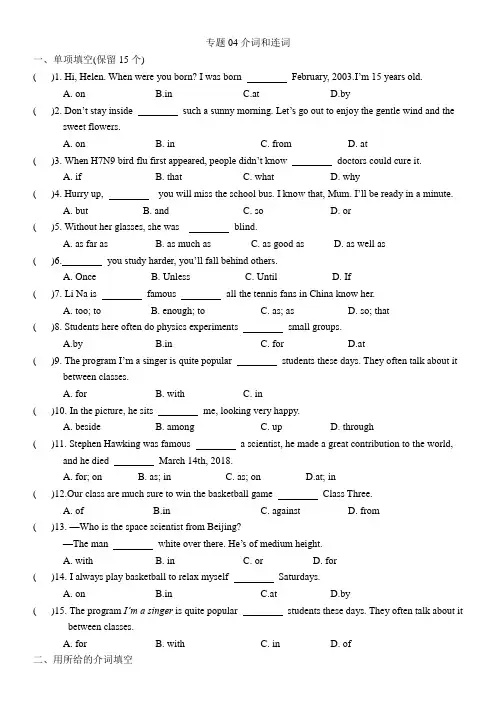
专题04介词和连词一、单项填空(保留15个)( )1. Hi, Helen. When were you born? I was born February, 2003.I’m 15 years old.A. onB.inC.atD.by( )2. Don’t stay inside such a sunny morning. Let’s go out to enjoy the gen tle wind and the sweet flowers.A. onB. inC. fromD. at( )3. When H7N9 bird flu first appeared, people didn’t know doctors could cure it.A. ifB. thatC. whatD. why( )4. Hurry up, you will miss the school bus. I know that, Mum. I’ll be ready in a minute.A. butB. andC. soD. or( )5. Without her glasses, she was blind.A. as far asB. as much asC. as good asD. as well as( )6. you study harder, you’ll fall behind others.A. OnceB. UnlessC. UntilD. If( )7. Li Na is famous all the tennis fans in China know her.A. too; toB. enough; toC. as; asD. so; that( )8. Students here often do physics experiments small groups.A.byB.inC. forD.at( )9. The program I’m a singer is quite popular students these days. They often talk about it between classes.A. forB. withC. in( )10. In the picture, he sits me, looking very happy.A. besideB. amongC. upD. through( )11. Stephen Hawking was famous a scientist, he made a great contribution to the world, and he died March 14th, 2018.A. for; onB. as; inC. as; onD.at; in( )12.Our class are much sure to win the basketball game Class Three.A. ofB.inC. againstD. from( )13. —Who is the space scientist from Beijing?—The man white over there. He’s of medium height.A. withB. inC. orD. for( )14. I always play basketball to relax myself Saturdays.A. onB.inC.atD.by( )15. The program I’m a singer is quite popular students these days. They often talk about it between classes.A. forB. withC. inD. of二、用所给的介词填空1. Happy birthday, Peter! Here’s a gift ______ (for/ in)you.2.I’ve ordered some flowers for grandma and they will arrive ______ (in/after)two hours.3.Blue whales are ______(in public/in danger).We should try to protect them.4. —I’m thirsty. I’d like a glass of orange juice.What about you, Andy?—I prefer a cup of tea ______(with/without)nothing in it.5.Most of the villagers took part in the races__(at/in) 9:00 a.m.__(on;in) the morning of June 18.6. —Bill, did you see Tom?—Yes, he just parked his car here and then hurried______(through/across) the street.7. Don’t stay inside.____(on/from) such a sunny morning. Let’s go out to enjoy the gentle wind and the sweet flowers.8. Our class are much sure to win the basketball game (of/against)Class Three.9. —Excuse me, could you please tell me how to get to the Concert Hall?—Sure. Go down the street, and you’ll find it(opposite/near) the Book City.10. More and more people in Qingdao go to work (with/by)subway now.三、用所给的连词填空1. My grandpa learns English for two hours every day, (although/since)he is over 70. Really? We should learn from him.2. My father wants me to be a doctor (and/or)an engineer, (so/but)I want to be an actor.3. ________(Both/Not only)the students _______(but also/and)their English teacher likes watching football games. They often play football after school, too4. Rick has learned a lot about Chinese culture (until/since) he came to China.5. This is new TV set,__ __ (but/or) I don’t like it.6. Mother wants to spend some time chatting with me __ ___( but/so) she is very busy every day.7. My parents want me to get further study to be _ ___(neither/either)an engineer___ _(nor/or) a scientist, __ __(and/but) I would like to be a famous surgeon doctor.8. —Mike, please turn down the music; __ _(both/neither) Lucy __ __ (nor/and) Lily are sleeping. —Sorry, I’ll do it right away.9. —Would you like to go to the cinema with us?—It sounds like fun, ___ ___(or/but)I’m too busy.10. —Why do you like going to Kunming for a holiday?—Because the weather there is __ __(either/neither)too hot ____ _(or/nor) too cold.四、词语运用阅读短文,从方框中选择适当的词并用其正确形式填空,使短文通顺、意思完整,每空限填一They were surprised that a child sho uld work out the problem ___1___they themselves couldn’t.___2___ the smallest kid of his family, Alex is always longing for the occasion ___3___ he should be able to be independent. Child as he is, he learns many thins from the books .It is generally considered unwise to give a child ___4___ he or she wants. His father was very strict with him when he was ___5___ school?He had never praised him___6___ he became one of the top students in his grade.Mr. Hall understand that ___7___ math has always been easy for him, it is not easy for the students.Maybe you have a habit that is driving your family crazy . It’s not easy to change habits, but ___8___ awareness and self control, it is possible.Those are the very words ___9___ he used.Alex plays football as well as, if not better ___10___ Mike. I think what he needs is more practice. Yes. That he needs more practice is clear.五、完形填空Hi, I’m Mr White! I’m __1__the Sunshine Music Club. I’m a great musician. I can play the piano, the violin __2__ the trumpet. And I’m very good __3__ the kids. I have a daughter. Her name is Maria. __4__she is only four years old, she can play the guitar, __5__ she plays it very well. She is __6__ the Sunshine Music Club, too.Do you like music? __7__ you also like music, please tell me, we can learn each other. Do you want to learn ___8__ music? Please come __9__ join us.We can help you__10__ music. My telephone number is 618-6588. My email address is White2012@.( )1. A. on B. in C. at D. of( )2. A. but B. and C. or D. with( )3. A. with B. of C. for D. at( )4. A. As B.Although C.Yet D. So( )5. A. while B. for C. or D. and( )6. A. of B. in C. on D. at( )7. A. as B. as if C. if D. as though( )8. A.at B. of C. for D. about( )9. A.or B. but C. and D. so( )10. A.at B. with C. in D. to参考答案:一、1—5 BAADC 6—10 BDBBA 11—15 CCBAB二、1.for; 2.in; 3. in danger; 4. with; 5.at/ on; 6. across; 7.on; 8. against;9.near; 10.by三、1. although; 2.or/ but; 3. Not only/ but also; 4. since; 5.but;6.but;7. either/ or/ but;8.both/ and;9.but; 10. neither/ nor四、1. while 2. As 3. when 4. whatever 5.at 6.until 7. although 8. with9.that 10. than五、1—5BBABD 6—10CBDCB。
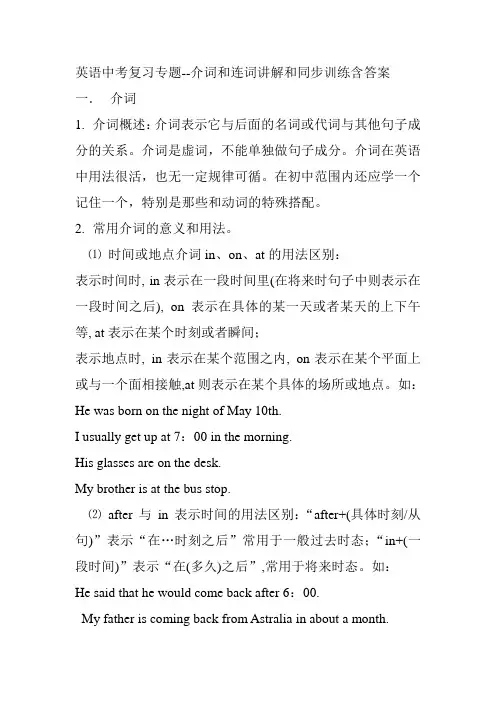
英语中考复习专题--介词和连词讲解和同步训练含答案一.介词1. 介词概述:介词表示它与后面的名词或代词与其他句子成分的关系。
介词是虚词,不能单独做句子成分。
介词在英语中用法很活,也无一定规律可循。
在初中范围内还应学一个记住一个,特别是那些和动词的特殊搭配。
2. 常用介词的意义和用法。
⑴时间或地点介词in、on、at的用法区别:表示时间时, in表示在一段时间里(在将来时句子中则表示在一段时间之后), on表示在具体的某一天或者某天的上下午等, at表示在某个时刻或者瞬间;表示地点时, in表示在某个范围之内, on表示在某个平面上或与一个面相接触,at则表示在某个具体的场所或地点。
如:He was born on the night of May 10th.I usually get up at 7:00 in the morning.His glasses are on the desk.My brother is at the bus stop.⑵after与in表示时间的用法区别:“after+(具体时刻/从句)”表示“在…时刻之后”常用于一般过去时态;“in+(一段时间)”表示“在(多久)之后”,常用于将来时态。
如:He said that he would come back after 6:00.My father is coming back from Astralia in about a month.⑶since与for表示时间的用法区别:“since+(具体时刻/that-从句)”表示“自从…起一直到现在”,“for +(一段时间)”表示“持续一段时间”,都常用于完成时态;如:My father has worked in this factory since 1970.My father has worked in this factory for over 30 years.⑷by、in与with表示方式的用法区别:都可以表示“工具、手段”,但是by主要表示“乘坐”某个交通工具或“以……方式”,在被动句中可以表示动作的执行者;in表示“使用”某种语言/文字,with表示“使用”某个具体的工具、手段。
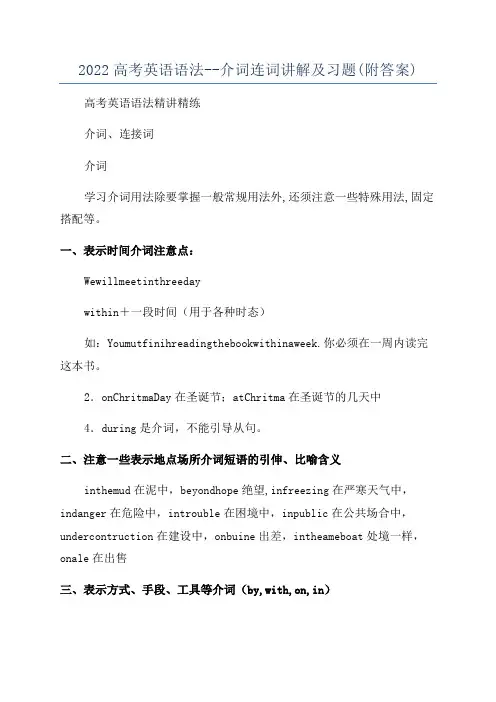
2022高考英语语法--介词连词讲解及习题(附答案)高考英语语法精讲精练介词、连接词介词学习介词用法除要掌握一般常规用法外,还须注意一些特殊用法,固定搭配等。
一、表示时间介词注意点:Wewillmeetinthreedaywithin+一段时间(用于各种时态)如:Youmutfinihreadingthebookwithinaweek.你必须在一周内读完这本书。
2.onChritmaDay在圣诞节;atChritma在圣诞节的几天中4.during是介词,不能引导从句。
二、注意一些表示地点场所介词短语的引伸、比喻含义inthemud在泥中,beyondhope绝望,infreezing在严寒天气中,indanger在危险中,introuble在困境中,inpublic在公共场合中,undercontruction在建设中,onbuine出差,intheameboat处境一样,onale在出售三、表示方式、手段、工具等介词(by,with,on,in)1.by:Theblindmenthoughttheycouldlearnwhattheelephantlookedli kebytouchingit./makealivingbyteaching/byhand手工地,靠手工地,byletter,bypot,byelectricity,learnth.byheart,truckbythebeauty因美丽而着迷Hewapaidbythehour/theday/month/…他按时/日/月/…被付给工钱。
byplane/train/hip/air/water/ea/…,bymeanof用…手段,方式;bywayof经由,取道于…learnEnglihby/over/throug h/ontheradio2.on:liveonfood,kneelonone¢knee,lie/leeponone¢back/ide/face 仰/侧/俯卧(睡)3.in:inEnglih,inink,inilence,inonevoice异口同声地,inahurry 匆忙地,inurprie惊讶地4.with:writewithapen,workwithone¢hand,mellwithone¢noe,beatt hehorewithawhip(鞭子)四、相近介词(短语)辨析about“关于”,知识性或随便谈论:adicuionabouttheplan3.over在…正上方,under在…正下方above在…上面(不一定垂直上方),below在…下面4.inanhour一小时后,用于将来时afteranhour一小时后,用于过去时5.beide在…旁边beide除…之外(还有)e某cept除…之外e某ceptfor除(非同类事物)之外6.on/inthetreetat50DongfengRoad在东风路50号高考英语语法精讲精练7.aholeinthewallapictureonthewallapieceofnewinthenewpaperthewordintheenvelopthemonkeyinthetreetheappleonthetree(树上的苹果。
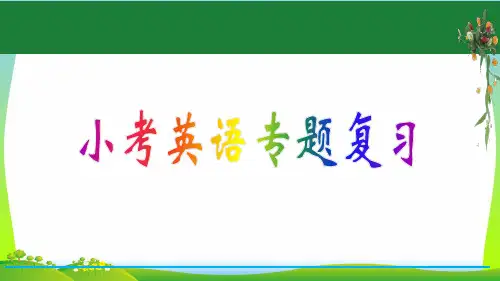
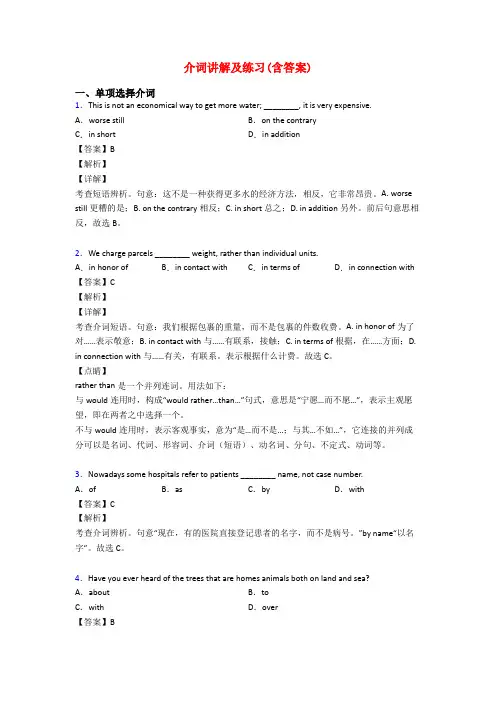
介词讲解及练习(含答案)一、单项选择介词1.This is not an economical way to get more water; ________, it is very expensive.A.worse still B.on the contraryC.in short D.in addition【答案】B【解析】【详解】考查短语辨析。
句意:这不是一种获得更多水的经济方法,相反,它非常昂贵。
A. worse still更糟的是;B. on the contrary相反;C. in short总之;D. in addition另外。
前后句意思相反,故选B。
2.We charge parcels ________ weight, rather than individual units.A.in honor of B.in contact with C.in terms of D.in connection with 【答案】C【解析】【详解】考查介词短语。
句意:我们根据包裹的重量,而不是包裹的件数收费。
A. in honor of为了对……表示敬意;B. in contact with与……有联系,接触;C. in terms of根据,在……方面;D. in connection with与……有关,有联系。
表示根据什么计费。
故选C。
【点睛】rather than是一个并列连词。
用法如下:与would连用时,构成“would rather…than…”句式,意思是“宁愿…而不愿…”,表示主观愿望,即在两者之中选择一个。
不与would连用时,表示客观事实,意为“是…而不是…;与其…不如…”,它连接的并列成分可以是名词、代词、形容词、介词(短语)、动名词、分句、不定式、动词等。
3.Nowadays some hospitals refer to patients ________ name, not case number.A.of B.as C.by D.with【答案】C【解析】考查介词辨析。
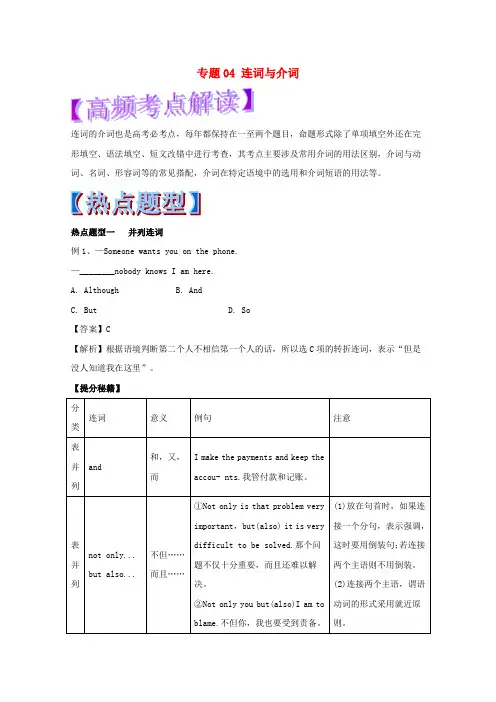
专题04 连词与介词连词的介词也是高考必考点,每年都保持在一至两个题目,命题形式除了单项填空外还在完形填空、语法填空、短文改错中进行考查,其考点主要涉及常用介词的用法区别,介词与动词、名词、形容词等的常见搭配,介词在特定语境中的选用和介词短语的用法等。
热点题型一并列连词例1、—Someone wants you on the phone.—________nobody knows I am here.A. AlthoughB. AndC. ButD. So【答案】C【解析】根据语境判断第二个人不相信第一个人的话,所以选C项的转折连词,表示“但是没人知道我在这里”。
【提分秘籍】【举一反三】There are fewer teaching positions left in big cities, ________at the same time there are shortages of teachers in small towns.A. orB. andC. soD. for【答案】B【解析】从语意可知,前后构成并列句,用and连接,在此处意为“而”。
热点题型二从属连词例2. ________ more and more forests were destroyed, some animals are facing the danger of dying out.A. ByB. WithC. AsD. For【答案】C【解析】考查连词和介词用法。
空格后是一个完整的句子,故用as来引导状语从句。
句意:随着越来越多的森林遭到破坏,一些动物正面临着灭绝的危险。
【提分秘籍】【举一反三】Jack wasn’t saying anything, but the teacher smiled at him ________he had done something very clever.A. as ifB. in caseC. whileD. though【答案】A热点题型三易混的介词例3、He was a good student and scored________average in most subjects.A. belowB. ofC. onD. above【答案】D【提分秘籍】1.over,above,on,beyond表示“在……上”(1)over一般表示“在……的正上方”“在……垂直上方”,其反义词是under;over还可表示在被覆盖在物体的上面。
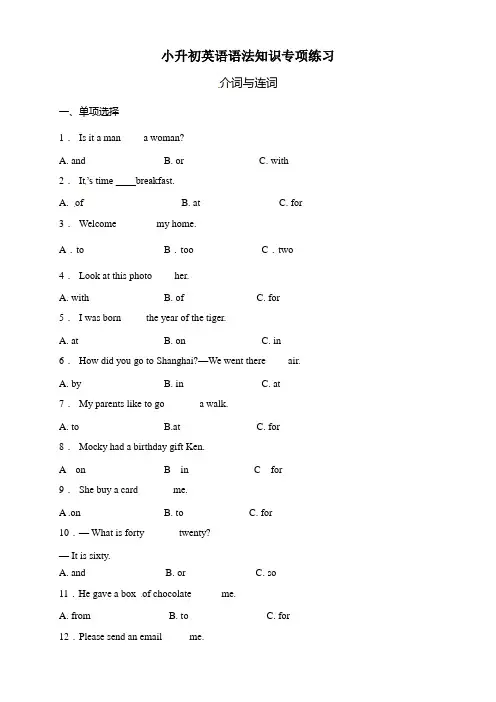
小升初英语语法知识专项练习介词与连词一、单项选择1.Is it a man ____a woman?A. andB. orC. with2.It’s time ____breakfast.A. ofB. atC. for 3.Welcome________my home.A.to B.too C.two 4.Look at this photo ____her.A. withB. ofC. for5.I was born ____ the year of the tiger.A. atB. onC. in6.How did you go to Shanghai?—We went there ____air.A. byB. inC. at7.My parents like to go ______ a walk.A. toB.atC. for 8.Mocky had a birthday gift Ken.A onB inC for9.She buy a card ______ me.A .on B. to C. for10.— What is forty ______ twenty?— It is sixty.A. andB. orC. so11.He gave a box of chocolate _____ me.A. fromB. toC. for 12.Please send an email _____me.A.toB.forC.on 13.He is wearing a blue suit ____a silver tie.A. withB. inC. of 14.---W here is the teachers’ office?---It’s _________ the second floor.A.onB.inC.near 15.My family have been living in Chengdu ______ Iwas born.A. forB. whileC.sinceD.when 16.Are you going to take part ________ the meeting?A. onB. atC. in 17.The hospital is next____the museum。
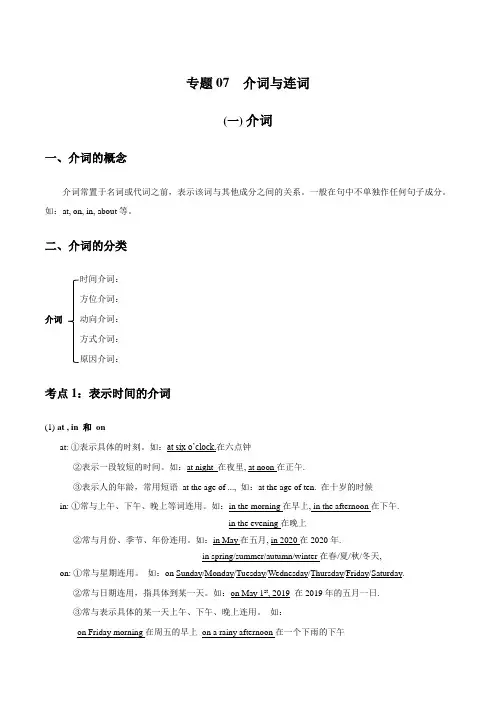
专题07 介词与连词(一)介词一、介词的概念介词常置于名词或代词之前,表示该词与其他成分之间的关系。
一般在句中不单独作任何句子成分。
如:at, on, in, about等。
二、介词的分类时间介词:方位介词:介词动向介词:方式介词:原因介词:考点1:表示时间的介词(1) at , in 和onat: ①表示具体的时刻。
如:at six o’clock.在六点钟②表示一段较短的时间。
如:at night 在夜里, at noon在正午.③表示人的年龄,常用短语at the age of ..., 如:at the age of ten. 在十岁的时候in: ①常与上午、下午、晚上等词连用。
如:in the morning在早上, in the afternoon在下午.in the evening在晚上②常与月份、季节、年份连用。
如:in May在五月, in 2020在2020年.in spring/summer/autumn/winter在春/夏/秋/冬天, on: ①常与星期连用。
如:on Sunday/Monday/Tuesday/Wednesday/Thursday/Friday/Saturday.②常与日期连用,指具体到某一天。
如:on May 1st, 2019 在2019年的五月一日.③常与表示具体的某一天上午、下午、晚上连用。
如:on Friday morning在周五的早上on a rainy afternoon在一个下雨的下午on the evening of May 5th在五月五日的晚上(2) before 和after 用来表示时间的先后顺序before:在……之前after:在……之后如:Spring comes before summer. 夏天之前是春天。
Come to my office after class. 放学后来我的办公室。
(3) from 用来表示从某段时间开始的动作,常与to 连用构成短语“from…to…”译为“从……到……”。
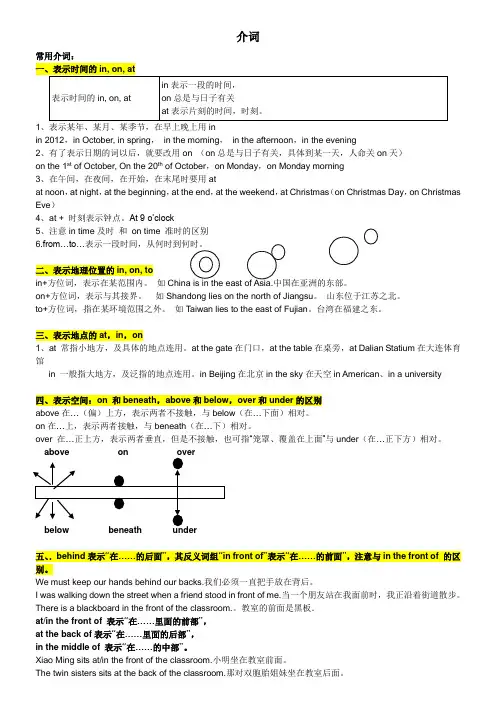
介词常用介词:1、表示某年、某月、某季节,在早上晚上用inin 2012,in October, in spring,in the morning,in the afternoon,in the evening2、有了表示日期的词以后,就要改用on (on总是与日子有关,具体到某一天,人命关on天)on the 1st of October, On the 20th of October,on Monday,on Monday morning3、在午间,在夜间,在开始,在末尾时要用atat noon,at night,at the beginning,at the end,at the weekend,at Christmas(on Christmas Day,on Christmas Eve)4、at + 时刻表示钟点。
At 9 o’clock5、注意in time及时和on time 准时的区别6.from…to…二、表示地理位置的in, on, toin+方位词,表示在某范围内。
如on+方位词,表示与其接界。
如Shandong lies on the north of Jiangsu。
山东位于江苏之北。
to+方位词,指在某环境范围之外。
如Taiwan lies to the east of Fujian。
台湾在福建之东。
三、表示地点的at,in,on1、at 常指小地方,及具体的地点连用。
at the gate在门口,at the table在桌旁,at Dalian Statium在大连体育馆in 一般指大地方,及泛指的地点连用。
in Beijing在北京in the sky在天空in American、in a university四、表示空间:on 和beneath,above和below,over和under的区别above在…(偏)上方,表示两者不接触,与below(在…下面)相对。
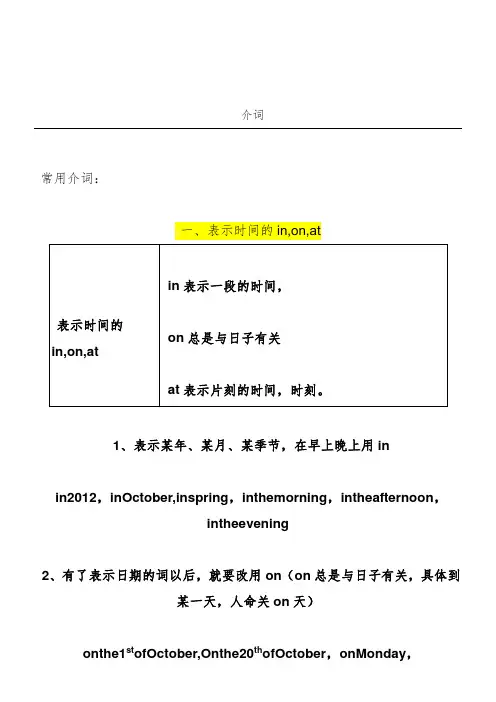
介词常用介词:intheevening2、有了表示日期的词以后,就要改用on(on总是与日子有关,具体到某一天,人命关on天)onthe1st ofOctober,Onthe20th ofOctober,onMonday,onMondaymorning3、在午间,在夜间,在开始,在末尾时要用atatnoon,atnight,atthebeginning,attheend,attheweekend,in+on+方位词,表示与其接界。
如ShandongliesonthenorthofJiangsu。
山东位于江苏之北。
to+方位词,指在某环境范围之外。
如TaiwanliestotheeastofFujian。
台湾在福建之东。
三、表示地点的at,in,on1、at常指小地方,及具体的地点连用。
atthegate在门口,atthetable在桌旁,atDalianStatium在大连体育馆aboveonover.behind表示“在……的后面”,其反义词组“infrontof”表示“在……的芃五、前面”,注意与inthefrontof的区别。
Wemustkeepourhandsbehindourbacks.我们必须一直把手放在背后。
Iwaswalkingdownthestreetwhenafriendstoodinfrontofme.当一个朋室后面。
Theteacherisstandinginthemiddleoftheclassroom.老师在教室中间站着。
六、表“用”时“with+工具、手段”(with“和”),“by+交通工具(单数)”,“in+语言、嗓音”。
Mydaughterboughtsomebookswiththemoneyshehadsaved.我女儿用她节省的钱买了些书。
不hetakesthetraintoShenyangeveryyear.Iusuallytakethesubwaytogohome.2、by+表示交通工具的名词,表示泛指乘某种交通工具。
初中英语语法专项练习八——介词一.选择填空:1.Mrs. Brown came to China ____ 1996.A.from B.of C.to D.in2.The room was full ____ smoke after the big fire.A.of B.with C.in D.for3.Here are some presents ____ you ____ our best wishes.A.to; with B.for; with C.of; about D.for; for4.Both Mr Green and Mrs Green were born ____ June, 1956.A.in B.at C.on D.for5.The little boy is always interested ____ science.A.with B.by C.in D.at6.Li Lei often gets up ____ seven o'clock on Sundays.A.on B.in C.at D.for7.They arrived early ____ a Tuesday morning.A.on B.at C.in D.of8.Macao(澳门)will return to our motherland ____ December 20th, 1999.A.on B.at C.in D.for9.----When were you born? ----I was born ____ August 25, 1983.A.on B.in C.at D.to10.Let me show you the place ____ the map.A.with B.on C.in11.John knows ____ a computer.A.how to use B.how use C.how uses12.The visitors ____ Japan arrived ____ Beijing Station last Tuesday morning. A.from; at B.of; to C.from; to D.of; on13.The teacher will be back ____ an hour.A.in B.after C.on14.This programme was sent to the USA ____ China ____ satellite.A.in; of B.of; in C.from; by D.by; from15.It's cold outside. Please your warm clothes.A. put inB. take offC. put onD. put up16.He got many gifts his birthday his friends.A. on, fromB. in, ofC. at, toD. from, for17.The classroom is quite different that one.A. ofB. fromC. withD. like18.Look, you'll see a bridge the river.A. onB. aboveC. overD. in19.–Your coat looks nice, Is It cotton? -Yes. It's Shanghai.A. made of, made byB. made of, made inC. made for, made inD. made from made by20.Tow may fall the others because he has missed so many lessons.A. afterB. behindC. laterD. out of二、用适当的介词填空1.What's wrong ____ your watch?2.One ____ the students is in the classroom.3.I think the shop is closed ____ this time of day.4.My father teaches English ____ a school.5.We have lunch ____ the middle of the day.6.You can buy some school things ____ your way home.7.I was born ____ July 1, 1982.8.May I borrow a pencil ____ you?9.Don't sleep ____ the open air.10.I often help my mother ____ _ the housework.11.It's time ____ school.12.I have quite a lot ____ homework to do.13.What's the time? It's half ____ seven.14.Ducks are good ____ swimming.15.What are you talking ____ ?16.He is sitting ____ the front of the car.17.The eraser was passed ____ one student ____ another. 18.Did you live ____ Beijing in 1997?19.When did you arrive ____ the village?20.I think Mary is ____ duty today.21.Eating too much isn't good ____ your health.22.I'm afraid he is ____ the cinema ____ the moment. 23.Thanks ____ asking me to your party.24.My watch is very different ____ yours.25.What's the weather ____ today?26.The student is asking his teacher ____ the sports meeting. 27.The farmers are all getting ready ____ the next year. 28.The radio says the wind will stop later ____ the day. 29.Let's go out ____ a walk, shall we?30.Tom, your mother is waiting ____ you.31.We have noodles for lunch for lunch ____ times. 32.Harerbin is ____ the north of China.33.The day ____ tomorrow will be windy.34.Don't worry ____ your test.35.I don't know which is the way ____ the park.36.An old woman is ____ the side of the road.37.____ the end of the road you'll see the hospital38.He left Tokyo ____ a visit ____ Beijing.39.Don't laugh ____ other people's mistakes.40.He did this instead ____ me.41.The people here are very friendly ____ us.42.Does he learn English ____ himself?43.I felt a little afraid ____ my teacher.44.I'm afraid he'll fall ____ the bike.45.Help yourselves ____ some fish, Lily and Lucy.46.____ these words he left the classroom.47.It was a pleasure ____ me.48.I'm sorry I'm late ____ the meeting.49.Study hard, or you won't catch up ____ your classmates. 50.Not far ____ him was Lin Tao.Lin Tao ran fast, too. 51.Mr Wu is going to tell us the result ____ once.52.He goes to school early ____ usual.53.It's another way ____ saying fast.54.I'm sorry he doesn't agree ____ me.55.He prefers playing football ____ playing basketball.56.What do you mean ____ baozhi?57.Don't play ____ fire.It's dangerous.58.He didn't go ____ bed until twelve o'clock.59.My teacher was angry ____ me.60.Someone is knocking ____ the door.61.Have you heard ____ Jim yet?62.If you break the window, you'll have to pay ____ it.63.I'm sorry.I won't talk to others in class ____ now on.64.What have you done ____ the milk?65.The students walked ____ the gates with Uncle Wang.66.Are you ____ trouble, Jim?67.My mother is ill.I have to send ____ the doctor.68.The doctor operated ____ my mother at once.69.The glass is full ____ milk.70.I saw him ____ the crowd.71.There are a group of sheep ____ the foot of the hill.72.We are twins.People often mistake us ____ each other.73.The knife is made ____ metal and wood.74.Ships can travel ____ the world.75.He watched me ____ surprise.76.Choose my subject.Something about English, ____ example.77.Tie the horse ____ the tree.78.Nothing can stop us ____ studying hard.79.____ Mr Wang's help, I have passed the exam.80.Please cut the metal ____ some pieces.81.I feel ____ going for a walk.82.We can finish the work ____ a week.83.Are you interested ____ the film Titanic?84.Hundreds ____ years ago, there was a village here.85.What ____ earth can you see?86.When did you join us ____ the game?参考答案:一、1.D.在年代前面用介同in2.A.full of是一个短语,意为“充满……”3.B.给“谁”的礼物,用介词for,with表示“带(着)”4.A.在年、月名称前用介词in,而在日期前则用on5.C.be/get/become interested in 对……感兴趣6.C.在“几点钟”,用at7.A.在“早、午、晚”前面,用介词in,但在具体某一天的“早、午、晚”前则用on 8.A.9.A.在日期前用介词on10.B.注意:on the map,on the paper,in the newspaper,in the book,这些短语中用不同的介词11.A.teach,tell,ask,learn等动词后可接“疑问词+to不定式”结构作宾语12.A.第一空填from表示“来自”;第二空填at是因为后面的名词中心词是station 13.A.in后面接表示一段时间的短语,用在一般将来时态中,表示“多长时间以后”14.C.from表示“从……”,by satellite通过卫星15.从句意理解,意为穿上暖和的衣服,应选 C16.具体某一天用介词 on,从朋友处得到礼物用from,故应选A17.be different from为固定搭配,应选B18.on表示河面上,above表示河上方,in表示河里,而over表示桥跨两岸,故应选C 19.衣服看出原料用 be made of,在哪里制造用be made in,故应选B20.意为他可能落后于其他人,落后为 fall behind,应选B1.with.What’s wrong with sb./sth.?某人/某物怎么啦?2.of.one of………之一此句的主语是one,of短语作定语3.at.at this time of day 在一天当中的这个时候4.at.at a(the)school在学校;at school在校读书5.in.in the middle of 在……(时间、地点的)中间6.on.on one's way(home)在某人(回家)的路上,way后面常接“to+名词短语”,表示……在去……的路上,因此句中的home是副词,故其前不加to7.on8.from.borrow…from从(某人或某处)借(入)某物比较 lend sth.to sb.把某物借(出)给某人9.in.in the open air“在野外/露天”,也可说成 in the open10.with.help sb.with.sth.帮助某人做某事11.for.注意 time的两种句型:It’s time for…(名词) It’stime to do sth.两个短语的意思都是:“该做某事了”或“做某事的时间到了”12.of.a lot of “许多”该短语既可修饰可数名词,也可修饰不可数名词此短语也可说成 lost of(多用于书面语)13.past.past意为“过……(多少时间)”14.at.be good at擅长……15.about.talk about 谈论,talk to 和……交谈16.in.in the front of……(物体内部)的前面比较 in front of 在……(物体外部)的前面17.from;to.from one to another从一个到另一个18.in.在较大的地名前用介词in19.at.到达小地方用介词at20.on.on duty值班、值日21.for,be good/bad for表示客观事物对某人如何,所以其它主语多为something或动名词be good/kind/friendly/bad to 多指某人对某人如何,其主语多为somebody 22.at; at.at the cinema 在电影院,at the moment 此刻、现在23.for.Thanks(Thank you)for(doing)sth.谢谢你(做某事)24.from.different from…与…不同25.like.like意为“象……”26.to.ask sb.to sth.邀请某人参加某项活动27.for.get ready for为……准备28.in.in the day在白天,也中说成 in the daytime29.for.go out for a walk出去散步30.for.wait for等待31.at.at times有时,间或32.in.in the north of 在……(内部的)北部33.after.the day after tomorrow后天34.about.worry about为……担心35.to.50.at 51.Atat the end在……的末端,末尾36.for;to.for a visit中的for表目的;a visit to…表“参观37.at.laugh at嘲笑38.of.instead of代替39.to.56.by oneself由自己40.of.feel afraid of感到害怕……,be afraid of害怕……41.off.fall off从……上摔下来42.to.help oneself to sth.随便吃/用/拿某物43.With.With these words说完这些话44.for.表示“(客观上)对……来说”45.for.be late for(做某事)迟到了46.with.catch up with 赶上47.behind.表示Lin Tao在he的后面此处用behind强调前后位置far后面还可接介词from,表示“远离”48.at.at once立即49.as.as usual象往常一样50.of.way of doing sth.做某事的方法way后面还可接to不定式做定语51.with.agree with同意某人的看法52.to.prefer(doing)sth.to(doing)sth.喜欢……胜过喜欢53.by.What do you mean by…?你(那么)说是什么意思?54.with.play with 玩弄……55.to56.with.be angry with 生某人的气57.at.knock at(on)敲58.from.hear from收到某人的来信59.for.pay for付……的钱此处作“赔偿”讲60.from.from now on从今往后61.with.do with处理、对付62.through63.in.in trouble陷入困境64.for.send for派人去请65.on.operate on给……做手术66.of67.among.among the crowd在人群中68.at.at the foot of在……脚下69.for.mistake…for…把……错当成……70.of.be made of由……制成(看得见原材料)比较 be madefrom 由……制成(看不见原材料)71.around.around the world全世界72.in.in.surprise惊奇地73.for.for example“例如”可置于句首、句中或句尾,只举出一个例子74.to.tie…to…把……绑在……上75.from.stop sb.from doing sth.阻止某人做某事76.With.with one’s help在……的帮助下77.into.cut…into pieces把……切成碎片78.like.feel like(doing)sth.想要(做)某物(事)79.in.in前面用can之类的情态动词,in表示“在……(多长时间)之内”;in与一般将来时连用,表示“在……(多长时间)之后”80.in81.of.hundreds of数以百计的82.on.此处意为“到底、究竟”,用在疑问词后on earth还可指“在世界上、在人世间”83.in.join sb.in sth.参加某人的活动初中英语语法专项练习九——连词1. He can speak English_______ Chinese.A. butB. alsoC. soD. and2. Physics is not so easy, _______I like it very much.A. butB. orC. sinceD. because3. Will Tom wait for her at home ______ at the library?A. orB. asC. so thatD. both4. She has a son _______ a daughter.A. butB. andC. soD. or5. I'll give her the gift ______ she arrives.A. soB. beforeC. as soon asD. since6. Tom was ____ill that we had to send for a doctor.A. soB. veryC. andD. too7. The woman was____ angry_____ she couldn't speak anything.A. neither…norB. either…orC. both…andD. so…that8. ______we got home it was very late.A. WhenB. WhileC. BecauseD. As9. We heard clearly_____ she said.A. whatB. whichC. beforeD. because10. I can't sleep well at night, ______I often feel very tired in the day.A. soB. becauseC. andD. or11. When you're learning a foreign language, use it, ______ you will lose it.A. butB. orC. thenD. and12. --- Can you play football?--- Yes, I can, ______ I can't play it very well.A. orB. andC. butD. so13. Study hard, ______ you will fall behind.A. andB. butC. soD. or14. My favorite is action movie ______ I think it's exciting.A. andB. becauseC. butD. so15. The boy is very smart, ______ many of his classmates like him.A. butB. soC. orD. for16. He has never heard______ seen such a thing before.A. norB. andC. orD. since17. _________ John _______I are policemen.A. Neither ... norB. Either ... orC. Both ... andD. Not only... but also18. Mr Smith teaches ______well ______ his lessons are not easily forgotten.A. very ... thatB. quite ... butC. so ... asD. so ... that19. He didn't go to sleep ______he finished his homework.A. tillB. beforeC. afterD. until20. I didn't buy the dictionary yesterday ________ my aunt would give me one.A. untilB. becauseC. ifD. before21. The runner fell _______ he quickly got up and went on running.A. orB. andC. butD. down22. Wait for me in the room _______ I come back.A. untilB. andC. soD. or23. I'll return the books to the library ______ soon as possible.A. asB. soC. justD. but24. Go along the road, _______ you'll find the market at the end of it.A. whenB. andC. orD. though25. You'll be late ______ you don't get up early tomorrow morning.A. ifB. whenC. beforeD. until26. It was late. She washed her face ______ went to bed.A. orB. andC. soD. but答案:1-5 DAABC 6-10 ADAAA 11—15 BCDBB16-20 CADDB21-26 CAABAB。
介词讲解及练习 ( 含答案 )一、单项选择介词1.The flight to Antarctica was delayed by the lack_______ information about the weather conditions there.A. in B. from C. for D. of【答案】D【解析】分析:考介短固定搭配。
句意:去南极洲的航班被延了由于缺乏那里的天气状况的信息。
by the lack of 固定搭配,缺乏。
故 D。
考点:考介短固定搭配。
2.Everything was perfect for the picnic ______ the weather.A. in place of B. as well as C. except for 【答案】 C【解析】本考的是辨析。
A in place of 表示“代替,取代”; BD. in case ofas well as 表示“又,也,”; C except for 意思是“除 ----之外”,表示在明了基本(整体)情况之后,再行明”; D in case of 表示“万一,假使”。
本句的意思是:除天气之外,所有情况于野炊来非常好。
在本句中,可以将“天气”看成是“所有情况”当中的一个,故C。
3.(江) Determining where we are ____________ our surroundings remains an essentialskill for our survival.A. in contrast to C. in face of 【答案】 D B.in defense of D. in relation to【解析】【解】考介短辨析。
句意:确定相于我周境的地理位置仍然是我生存的基本技能。
A. in contrast to 与⋯⋯形成照; B. in defense of⋯⋯;C. in face of面⋯⋯;D. in relation to 涉及,相于。
语法系列复习专题-----介词、连接词介词一、表示时间介词注意点:时间介词in、on、at、by、during的用法1.介词in用来表示一天中某段时间,指天、年、月、季节、周次等。
如:in the morningin+一段时间=in+一段时间's time(与将来时连用)如:We'll meetin three days' timewithin+一段时间(用于各种时态)如:You must finish reading the book within a week.你必须在一周内读完这本书。
2.介词on用来表示某一天或星期几,指明具体的时间。
如:on a rainy dayon Christmas Day3.介词at用来表示特定的时间、节日、年龄等。
如:at noon at Christmas4.介词by表示…的时候、到、等到…已经等用在天、时间的前面。
如:by 2 o’clock5.up to now=until now, from morning till night, for the time being暂时,at times有时,day by day一天天地,in no time立刻。
6.during是介词,不能引导从句。
二、注意一些表示地点场所介词短语的引伸、比喻含义in the mud在泥中,beyond hope绝望, in freezing在严寒天气中,in danger在危险中,in trouble在困境中,in public在公共场合中,under construction在建设中,on business出差,in the same boat处境一样,on sale在出售三、表示方式、手段、工具等介词(by,with,on,in)1.by:The blind men thought they could learn what the elephant looked like bytouching it./make a living by teaching/ by hand手工地,靠手工地,by letter,by post, by electricity, learn sth. by heart, struck by the beauty因美丽而着迷by means of用…手段,方式;by way of经由,取道于…learn English by/ over/ through/ on the radioHe was paid by the hour/ the day/ month/…他按时/日/月/…被付给工钱。
七年级语法知识一.教学内容:介词及连词二.重点、难点:介词及连词用法专项练习[具体内容]一.介词(一)表示时间的介词(1)at①接具体时间:eg. at six, at half past two, at ten to twelve②表示“在.. 时刻”;eg:at noon, at midnight(2)in①表示“在(某段时间段)之间”;eg. in January, in a month, in spring, in 2005②在将来时中,表示“在某段时间之后” eg. In ten years, I think I,ll be a reporter.(3)on表示在具体的某一天或某一天的上午、下午或晚上等。
eg. On Monday, On Tuesday afternoon, On May 4th, On the morning of July 6th(二)固定搭配的介词(1) 动词 +介词:100k after, look at, look for, laugh at, listen to, hear from, turn on, turn off, wait for, worry about, think of, spend…on(2)介词 +名词:by train, on foot, at the end of, at last, in the end, in trouble, at table, at breakfast, in hospital, in time, on time, on one,s way to, with pleasure(3)be+形容词 +介词:be afraid of, be good at, be good/ bad for, be late for, be interested in, be angry with, be full of, be sorry for二.连词(conj.)用来连接词与词或句与句(1)并列连词(用来连接平行的词、词组或分句)①表并列关系:not only...but also, neither...nor, and②表选择关系:or, either...or③表转折关系:but, while④表因果关系:for, so(2)从属连词(用来引导从句)①引导时间状语从句:after, before, when, while, as, until, till, since, as soon as②引导原因状语从句:because, as, since③引导目的状语从句:so that, in order that④引导结果状语从句:so that, so...that, such...that⑤引导比较状语从句:than, as...as⑥引导宾语从句:that, if, whether【典型例题】介词是一种虚词,它不能单独使用,后面要踉名词、人称代词宾格或动名词。
介词一、单项选择1.Mr. Smith always encourages his students to be active _______class.A.inB.byC.withD.from2. It is going to rain,Take an umbrella _______you.A.withB.atC.inD.from3.-Andy practiced hardest among us and he won first prize in the competition.-A dream can't come true_______ hard work.A.byB.acrossC.overD.without4.-Many doctors and nurses went to Hubei in February.-Hubei is far from Heilongjiang.It's _______ the south of China,_______ the south of Henan.A.in;toB.on;toC.in;onD.at;in5.It's hard to turn down a banana.They taste good and you don't have to wash them _______eating them.A.untilB.afterC.beforeD.unless6.The Chinese survey team remeasured (重新测量)Qomolangma successfully _______May 27,2020.A.inB.onC.atD.with7.We have a geography lesson_______ three o'clock_______ Thursday afternoon.A.at;inB.in;inC.on;onD.at;on8.-What time is it?-It's half _______ seven.A.pastB.toC.atD.in9.-Did you go on the Silk Road trip by train?-Yes.The train was great,just like a hotel _______ wheels-it had all that I needed.A.inB.atC.onD.by10.In the last few months,the teachers have given lessons_______ the Internet as webcasts(主播).A.forB.atC.inD.on11.My hometown,Kunming,is famous _______ fresh flowers. No matter when you visit it,they will catch your eye.A.asB.forC.ofD.by12.-In order to win the new pneumonia Resistance War(抗击新型肺炎战),many heroes lost their lives.How great they are!-Yeah.China is quite an unusual country. I take pride_______my motherland.A.ofB.forC.inD.with13.-Mom,look at all the clothes I bought on-line.-Again? You shouldn't spend so much money ____ clothes.A.inB.forC.onD.with14.I will volunteer for a two-day home stay for an exchange student from the UK.I consider it agood chance to show Chinese food _______ our kindness.A.as well asB.so well asC.as good asD.so good as15.-Xining is getting more and more beautiful.-Oh,yes.I think more changes are _______.A.on the radioB.in the endC.on the wayD.by the way16.-Sorry, I didn't do a good job.-Never mind._______,you've tried your best.A.As forB.In totalC.In that caseD.After all17.We planted some flowers _______ garden yesterday.A.onB.toC.inD.of18.-Do you have this T-shirt in a different color?-I'm afraid not. It only comes _______red.A.ofB.inC.forD.on19.He wrote his phone number_______ a piece of paper.A.onB.forC.inD.from20.-Thanks to our government,we can have a new library next week.-That's great!And we will read books there _______ a month.A.beforeB.inC.byD.until21.In the picture,he sits_______ me, looking very happy.A.besideB.amongC.upD.through22.Sorry,this is your letter,but I opened it_______.A.by mistakeB.by accidentC.by myselfD.by chance23.-What do you like to do in your spare time?-I like collecting train tickets,and I have a collection of 100 _______ now.A.in commonB.in totalC.in dangerD.in silence二、根据句子中所给的单词首字母或中文提示,填写正确的单词24.The heavy rain is beating a_______ the window.25. I can't finish the job on time w_______ your help.26.Peter is the tallest a _______ the three boys.27.Don't go a_______ the road.The lights are red.28.Flying in the sky,we can see the fascinating city_______(在·······下面).29._______(除······之外)singing English songs, there are many other fun ways to learn English.30.The shop is _______(在······之间)the post office and the bookstore.31.Though your children are _______(与······在一起)you,they are not yours.32.His grandfather has been dead _______(自从 (1990)1.A2.A3.D4.C5.C6.B7.D8.A9.C 10.D 11.B 12.C 13.C 14.A 15.C 16.D 17.C18.B 19.A 20.B 21.A 22.A 23.B 24.against 25.without 26.among 27.across 28.below 29.Besides30.between 31.with 32.since连词一、单项选择1.She says that she’ll have to close the restaurant_______ business improves.A.ifB.afterC.unlessD.when2.I don't like Sun Cinema _______ it has bad service.A.becauseB.althoughC.unlessD.until3.You'd better tidy up your mom _______ your father comes back.A.soB.orC.beforeD.but4.We still know little about the Moo _______ men have landed on it.A.ifB.sinceC.althoughD.because5.In some cities of China,you'll get fined_______ you don't walk along the crosswalk while crossing the road.A.ifB.thoughC.untilD.unless6.Wash your hands before meals, _______ you may get ill.A.andB.butC.orD.so7.Mike and Jim's room is tidy, _______ their sister's is not.A.butB.andC.orD.because8.Swimming is,of course,interesting. But_______ we plan to go swimming, being safe must come first.A.thoughB.whenC.unlessD.since9.I was still feeling hungry _______ had eaten some sandwiches.A.soB.thoughC.sinceD.until10.This cap is nice,_______ it doesn't look good on me.A.forB.soC.butD.or11.-Jim,let's go out to play basketball.-Oh,I won't do that _______ I finish my homework.A.ifB.untilC.becauseD.since12.-Your father has passed the driving test?-Yes. _______my father_______my mother has.A.Not only;but alsoB.Neither;norC.Either;orD.Both;and13.There's no ticket left for Lang Lang's piano concert. _______your_______your sister can go to it.A.Both;andB.Not only;but alsoC.Either;orD.Neither;nor14.“You can't have both of them. You can choose_______ the kite_______ the toy car",said the mother.A.either;orB.not only;but alsoC.both;andD.neither;nor15.Be careful ,_______ you'll make fewer mistake in the experiment.A.andB.butC.asD.or16.The bell rang _______ the teacher was talking to Lily.A.untilB.beforeC.whileD.after17.-I'm afraid e-book» might be bad for our eyes.-Hmm,but they will be helpful for us _______ we put them to good use.A.as soon asB.as long asC.even thoughD.so that18.I'll send you a message _______ I get to school.A.sinceB.so thatC.as soon asD.though19.You'd better leave now _______ you can catch the early bus.A.so thatB.as soon asC.because ofD.if20.Miss Lin has taught us English _______ we came to this school.A.forB.sinceC.beforeD.when21.He always works _______ hard_______ he does well in every subject.A.too;toB.so;thatC.such;thatD.not;until22.-My parents are crazy about Running Man.How about your parents?-_______ my dad_______ my mom likes it.They are interested in The V oice of China.A.Not only;but alsoB.Both;andC.Either;orD.Neither;nor二、根据句子中所给的单词首字母或中文提示,填写正确的单词23.A_______ a busy morning at work,lunchtime gives me a chance to do many things,such as exercise,read and watch TV.24.Andrew was crazy about DIY,b_______ he always made his room dirty and untidy.25.Some climbers have dreamed of getting to the top of Mount Qomolangma f_______ a long time.26.The noise made sleep impossible, s_______ I got up and read a book.27._______ outbreak of COVID-19 is a terrible blow to the country, the government is trying hard to bring the situation under control.1.C2.A3.C4.C5.A6.C7.A8.B9.B 10.C 11.B 12.A 13.D 14.A 15.A 16.C 17.B18.C 19.A 20.B 21.B 22.D 23.After 24.but 25.for 26.so 27.Although/Though。
介词和连词中考命题趋势考纲解读(介词和连词在近5年考试中的考查点)1. 熟悉和掌握常用介词和连词的用法。
2. 了解和运用一些常见的介词短语及连词的使用方法。
3. 能正确区分并列连词和从属连词,并掌握其用法。
命题预测1. 介词的考查方式以单项选择的形式为主,也会在单词拼写、完形填空中进行考查。
2. 据统计,介词的常考点有:(1)表示时间的介词,如:2019·临沂,17题;2019·咸宁,30题。
(2)表示地点方位的常用介词,如:2019·大庆,2题。
(3)表示方式、手段或工具的介词,如:2019·云南,21题。
(4)介词的常见搭配,如:2019·徐州,7题。
连词的考点有:(1)并列连词的用法,如:2019·绥化,6题;2019·临沂,28题。
(2)从属连词的用法,如:2019·长春,13题;2019·乐山,30题。
3. 预计今后中考中介词考查的重点将是其基本用法(同时也要注意介词的常见搭配的情况);连词的考查将以并列连词和从属连词基本含义为重点,也要注意考查连词的特殊用法,比如:“就近原则”,不能出现在同一个句子中的连词等。
一、介词概述:介词又叫前置词,是一种虚词。
介词是一种用来表示词与词或者词与句之间的关系的词,在句中不能单独作句子成分。
介词一定要有宾语,充当宾语的一般有名词、代词或相当于名词的其他词、短语或句子。
如:I am in school. in the morningThanks for helping me. What about going for a walk?二、介词的句法功能:介词不能独立在句中作成分,介词后必须与名词、代词或动名词构成介词短语在句中充当一个成分,表示人、物、事件等与其他人、物、事件等之间的关系。
1. 作定语:The book on the table is mine.2. 作状语:We have breakfast at seven. (表时间);They were late for meeting because of the heavy rain. (表原因);They started the machine by pressing the button. (表方式)3. 作表语:My dictionary is in the bag.4. 作宾语补足语:I found him in the office.三、介词分类:①时间介词;②方位介词;③方式介词;④目的介词;⑤原因介词;⑥运动方向介词;⑦比较介词等等。
介词常用介词:1、表示某年、某月、某季节,在早上晚上用inin 2012,in October, in spring,in the morning,in the afternoon,in the evening2、有了表示日期的词以后,就要改用on (on总是与日子有关,具体到某一天,人命关on天)on the 1st of October, On the 20th of October,on Monday,on Monday morning3、在午间,在夜间,在开始,在末尾时要用atat noon,at night,at the beginning,at the end,at the weekend,at Christmas(on Christmas Day,on Christmas Eve)4、at + 时刻表示钟点。
At 9 o’clock5、注意in time及时和on time 准时的区别6.from…to…二、表示地理位置的in, on, toin+方位词,表示在某范围内。
如on+方位词,表示与其接界。
如Shandong lies on the north of Jiangsu。
山东位于江苏之北。
to+方位词,指在某环境范围之外。
如Taiwan lies to the east of Fujian。
台湾在福建之东。
三、表示地点的at,in,on1、at 常指小地方,及具体的地点连用。
at the gate在门口,at the table在桌旁,at Dalian Statium在大连体育馆in 一般指大地方,及泛指的地点连用。
in Beijing在北京in the sky在天空in American、in a university四、表示空间:on 和beneath,above和below,over和under的区别above在…(偏)上方,表示两者不接触,与below(在…下面)相对。
on在…上,表示两者接触,与beneath(在…下)相对。
over 在…正上方,表示两者垂直,但是不接触,也可指“笼罩、覆盖在上面”与under(在…正下方)相对。
五、.behind表示“在……的后面”,其反义词组“in front of”表示“在……的前面”,注意与in the front of 的区别。
We must keep our hands behind our backs.我们必须一直把手放在背后。
I was walking down the street when a friend stood in front of me.当一个朋友站在我面前时,我正沿着街道散步。
There is a blackboard in the front of the classroom.。
教室的前面是黑板.at/in the front of 表示“在……里面的前部”,at the back of表示“在……里面的后部”,in the middle of 表示“在……的中部”。
Xiao Ming sits at/in the front of the classroom.小明坐在教室前面。
The twin sisters sits at the back of the classroom.那对双胞胎姐妹坐在教室后面。
The teacher is standing in the middle of the classroom.老师在教室中间站着。
六、表“用”时“with+工具、手段”(with“和”),“by+交通工具(单数)”,“in+语言、嗓音”。
My daughter bought some books with the money she had saved.我女儿用她节省的钱买了些书。
He told us something interesting in Japanese.他用日语告诉了我们一些有趣的事情。
As a middle school student, don't write with a pencil.作为一个中学生,不要用铅笔写字。
He always goes to school by bus. 他总是坐公共汽车去学校。
交通方式常用的表达方法1、take + the + 表示交通工具的名词,在句中做谓语。
he takes the train to Shenyang every year.I usually take the subway to go home.2、by + 表示交通工具的名词,表示泛指乘某种交通工具。
by bus、by bike、by train、by taxi、by subway、by ship=by sea=by water、by plane=by air=on a plane、on foothe goes to Shenyang by train every year.I usually go home by subway.3、on、in + 限定词+ 表示交通工具的名词,可用来表示具体的交通方式。
一般情况下,无厢、无舱的只能用on,如on the bike,其他的既可以用in,也可用on。
如in\on the plane。
但是只能说in the car、in the taxi,不能说on the car、on the taxi。
I hope more and more people go to work on their bikes.I usually take my daughter to school in my car.4、动词+ to + 地点名词,动词有walk、ride、drive、fly等可直接表达交通方式,后接to可跟地点名词,表示“通过、用……去某地”I hope more and more people ride to work.I usually drive my daughter to school.七、表示“在……上”时,不是都用“on”,有时须用in。
在树上in the tree 用于指树上的鸟、人等。
on the tree用于指生长在树上的叶子、果实。
在墙上in the wall镶嵌在墙内,指窗户、门、钉子等。
on the wall在墙的表面之上,指地图、画像等。
在报纸上in the newspaper用于指报上的内容。
on the newspaper用于指放在报纸上的东西,如眼镜等。
八.“across+表面”表示“横过”;“through+空间”表示“穿过”、“贯穿”;“over”表示从上面“越过”The Changjiang River is too wide for so young a boy to swim across.长江太宽了,这么小的孩子游不过去。
The plane flew over the high mountains.飞机飞越了群山。
The sunshine got into the room through the glass. 阳光透过玻璃进入房间。
九、从属关系中用“to” 的情况the key to the door门的钥匙,an answer to the question 问题的答案,a reply to our letter 对我们信的答复,the entrance to the building 大楼入口处,the monument to the heroes 英雄纪念碑注意:◆in+颜色,表示穿着…… in red, Mary is in red today.玛丽今天穿了一件红衣服。
◆in + Row/ Team/ Class/ Grade等,表示“在……排/队/班级/年级”等。
◆in the desert在沙漠、in the forest在森林、in the grassland在草原、in the jungle在热带丛林、in thewild在野外、在荒野(应注意此类短语中有the。
)◆in the sun(在阳光下) 、in the sky(在天上)、in bed(在床上)、in the middle of(在中间)、in the street(在大街上)in the world在世界上、in one’s life在(某人)一生中、He is in his twenties. 他二十几岁了。
◆on the right(在右边)、on the left(在左边)、on the right side of 在什么的右边、on the other side of 在什么的另一边◆on/in the playground在操、on the farm=on farm在农田、on the river在河边河畔、on the coast在海岸边、on the east coast of 在…东海岸、◆on the phone在电话里,通过电话、on/over the radio在收音机里、on TV在电视上、on the computer在电脑里、on the Internet在因特网上(go online上网上线)◆at work(在工作)、at school(上学)、at home(在家)应注意此类短语中无the。
◆at the age of ten在他十岁时间、at the same age同岁、at the foot of the hill(在山脚下)、at the North Pole在北极、at the South Pole在南极、at the speed of…以…速度、at the price of…以…价格、◆yesterday、tomorrow、today、last…、next…、this…前面不该用任何介词.the night before last.“在前天的夜里”,与“在前天”the day before yesterday相仿,前面不该用任何介词,连词连词是一种虚词,它不能独立担任句子的成分而只是起连接词与词、短语与短语、句子与句子的作用,它的用法通常是通过辨析词义来使用。
1、常见的连词and 和(表连接)but 但是(表转折)if 如果(表条件)so 所以(表结果)because 因为(表原因)then 那么(表承接)or 或者(表选择)2、易混淆的连词辨析(1)and和or:在并列结构的句子中,or通常用于否定句and 用于肯定句(2)so 和because:because意为“因为”,so意为“所以”,但是英语中不可以用because…so…表示因果关系。
(3)表示二者之间的联系:both…and…(两者都…), not only…but(also)…(不但……而且……),neither…nor…(既不……也不……)介词练习一、填空。